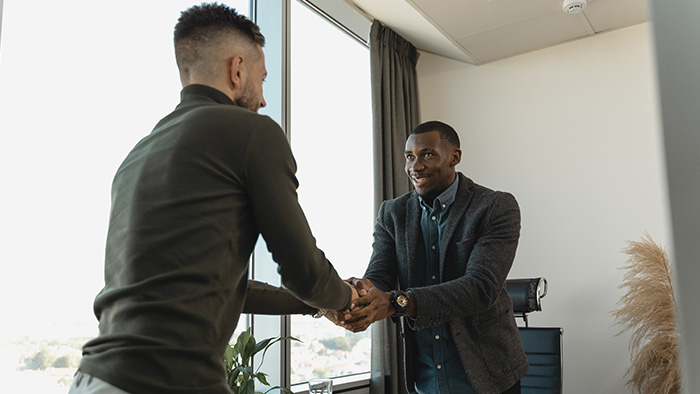
Here's what we'll cover:
The number one question to ask before any type of communication is “Who is my audience?” Why? Because all effective communication is audience-based — focused on the type and specific needs of that audience. Excellent communicators ask: “How can I make my message a benefit to my audience?”
Interviewing is no different.
Harry Emerson Fosdick, a master orator and legendary author, said it this way:
“There is nothing that people are so interested in as themselves, their own problems,and the way to solve them.”
Fosdick wisely points out 3 things:
People are interested in themselves.
They’re interested in their own problems.
They’re interested in figuring out ways to solve their problems.
By re-framing the interview process as a means of connecting with the interviewers as people, we position ourselves to understand their needs. Then we can demonstrate our skills and talents as a way of solving their problems.
This creates a mindset of service where we are focused on helping the other person, rather than putting the spotlight — and all of the pressure — on ourselves.
Let’s examine what motivates interviewers, how you can connect with them on a more human level, and how you can position yourself as a guide — the person with the skills and experience that helps them solve their problems.

What Are the Motivations of an Interviewer? (Your Audience)
The interviewer is ultimately interested in himself and his problems. He has a problem job opening at work right now. He has a job to fill. He is looking to solve that problem without creating another problem (a bad hire). The interviewer is obviously commissioned with a task: find the right person for the job.
Therefore, the focus of the interview becomes seeking to meet the needs of the interviewer — helping the interviewer be successful in solving their problem.-- This also frees up the interviewee to relax, trust the process and believe in their preparation that they are either a great fit or they are not.
Typically, every interviewer has a boss they are trying to please. It could be the HR department, the governor who appointed the nominating committee, an owner, or anyone in between. Usually, they have outside pressure being placed on them. Prior to our interview we need to assess and prepare by understanding the interviewer's circumstances. We need to be prepared to use our strengths to be an asset, or the answer, to his problems.Developing our “question asking skills” is crucial to interviewing well.
The beginning of the interview then becomes a process of mining for information, asking good questions to determine the scope of the interviewer’s problems.
When going into an interview, remember to ask yourself:
Who is my audience?
What motivates them?
What are their problems?
What strengths do I have to help them win?
By reframing your mindset to ask: “Who is my audience?”, “ What are their problems?” and “How do I help them win?” you take the pressure and spotlight off of yourself and put your energy towards helping a person with a problem. This makes the interview experience feel less like a clash between you and this giant entity and closer to the reality of the situation: Just a person trying to help another person.
We’ve discussed our audience and we’ve explored what motivates them. Now let’s take a deep dive into how we help them win.

How You Help Your Interviewer (Your Audience) Win
Donald Miller is the author of the book Building a StoryBrand. In his work, Miller points out that every story has a hero and that we are all the heroes of our story.
In Miller’s messaging, the hero has a problem and meets a guide. The guide gives them a plan, calls them to action and helps them find success and not failure.
Most candidates come into interviews doing all they can to point out what a great hero they are, and how they would be a great hero for the company.
Remember: The interviewer is not looking for a hero. They are looking for a guide to help them solve their problem, which is finding the right person for the job.
If we look at Donald Miller’s diagram below, see yourself as a guide and the interviewer as the character.

When you position yourself as a guide to help the main character of the story (the interviewer) be successful, you have put yourself in a prime position to land a job.
This concept is obviously easier to apply when you are not desperate for a job. In some situations you simply need to do all you can to get a job and focus on how you have the ability to solve the interviewer's problems.
If you are not desperate, you must be willing to recognize that you may not be the best fit for the job, and the job may not be the best for you. Part of the interview process is for you to assess the suitability for you.
At this point, it’s important to point out how you can change the pronouns during the interview. As a guide, we make our pronouns others-centered — “you”, rather than “I.”
As an example, rather than opening with, “I am able to produce budget forecasting excellently and have done so for the last 10 years,” change the initial pronoun to, “You want someone with an excellent budget forecasting history and experience, and that’s the type of person I am. In fact, over the last 10 years, I have been a major help to my organization in that area.”
Learning the nuance of meeting the needs of the interviewer — and how you can be a help to them — is one important mind shift in successful interviewing. By making this change, you put their problems in the spotlights and show that you have the skills to help them solve them.
Thanks for reading,
Chris


 Job Search
Job Search

